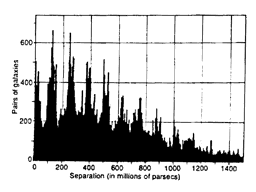 |
Science Frontiers ONLINE No. 69: May-Jun 1990 |
|
|
Megawalls Across The Cosmos
"The universe is crossed by at least 13 vast 'walls' of galaxies, separated by about 420 million light years, according to a team of British and American researchers. The walls seem to be spaced in a very regular way that current theories of the origin of the universe cannot explain."
 "Walls" of galaxies emerge when galaxy separation distance is plotted against the number of galaxies possessing specific separation distances. (128 million parsecs = 420 million light years). |
(Henbest, Nigel; "Galaxies Form 'Megawalls' across Space," New Scientist, p. 37, March 19, 1990.)
Comment. Not mentioned in the above article are the papers by W.G. Tifft on quantized redshifts. (See SF#50, for example.)
It will be interesting to learn if "boreholes" pointed in other directions will encounter the same megawalls. If they do, the earth will be enclosed by shells of galaxies, much as some elliptical galaxies are surrounded by shells of stars. Wouldn't it be hilarious if the earth were at the center of these concentric shells? Some measurements of the universe's rotation also seem to imply geocentrism! It is more likely, however, that redshifts are just poor cosmological yardsticks. See our Catalog volume Stars, Galaxies, Cosmos for more on these subjects. Ordering information here.